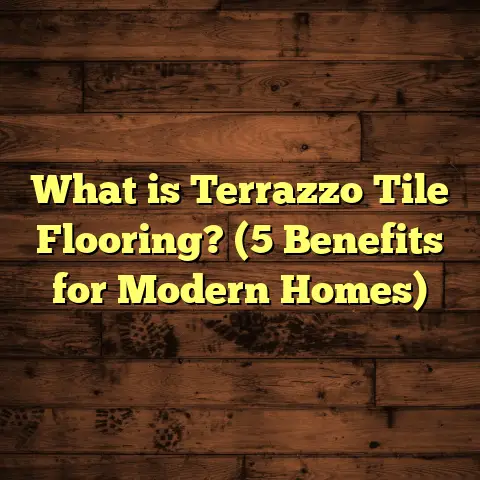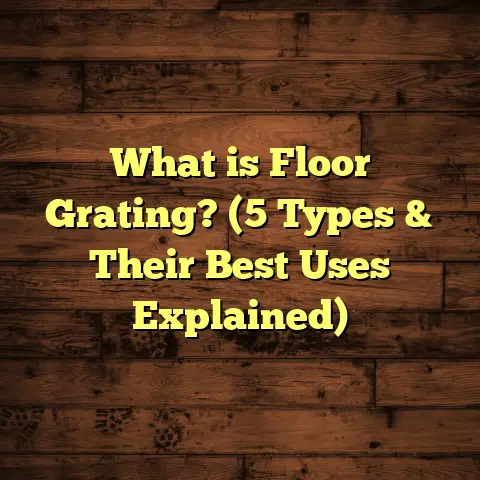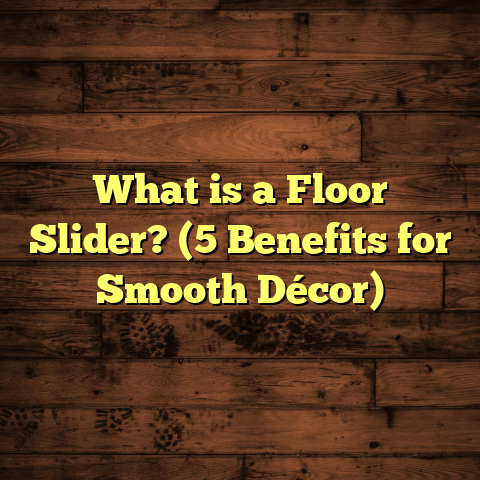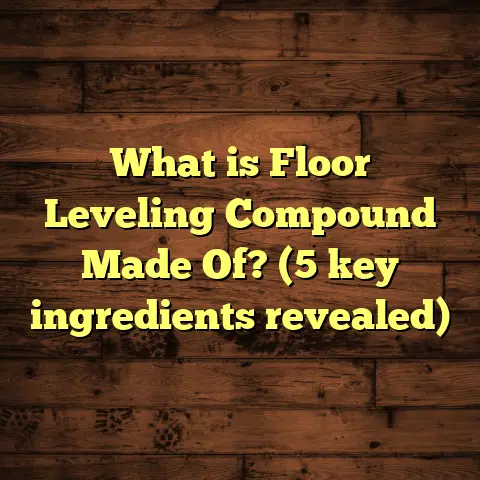What is Composition Flooring? (5 Key Benefits You Must Know)
How to Choose Flooring That Lasts and Impresses: My Take on Composition Flooring
Hey! If you’re thinking about new floors and want something durable, stylish, and budget-friendly, then I’ve got some cool insights for you. I’ve been working with all kinds of flooring materials for years, and today I want to share what I’ve learned about composition flooring. I’ll break it down in a way that’s easy to understand, share some personal stories, and give you facts and figures that helped me make smart choices on my own projects.
What Is Composition Flooring?
So, you might be wondering, what exactly is composition flooring? Simply put, it’s a type of flooring made by combining different materials—usually a blend of wood fibers, plastic resins, and other compounds—to create a product that mimics natural flooring but offers better durability or affordability.
Unlike solid hardwood or simple vinyl, composition flooring uses layers or a mix of substances designed to give you the best of several worlds: strength, water resistance, ease of cleaning, and often a more realistic look. For example, some composition floors have a wood-like appearance but are actually made mostly from recycled materials and plastics. Others use a layered structure to prevent warping or cracking.
I first encountered composition flooring about ten years ago when a client wanted something tough for their busy family room without spending a fortune on exotic hardwood. After installing composition flooring there, I was hooked because it held up so well against spills, pets, and heavy foot traffic.
Types of Composition Flooring
There are a few common types:
- Luxury Vinyl Composition Tile (LVCT): Made from vinyl mixed with other compounds. It’s highly popular in commercial settings.
- Composite Wood Flooring: Combines wood fibers with plastic resins for stability.
- Rubber Composition Floors: Used in gyms or play areas; a mix of rubber and other materials.
- Engineered Composite Floors: Layers of different materials fused together for strength.
Each one has its own strengths, but they share the idea of combining materials to get better performance than any single one alone.
5 Key Benefits You Must Know About Composition Flooring
Let me tell you what makes composition flooring stand out from my experience and research. These benefits might just make it the perfect fit for your home or project.
1. Durability That Handles Life’s Messes
Durability is the first thing I usually think about when choosing floors. Composition flooring really shines here.
When I installed composition flooring in my own kitchen a few years ago, I was amazed at how well it resisted stains and scratches. This stuff takes a beating.
- Scratch Resistance: Many composition floors come with a wear layer that protects against daily scuffs.
- Water Resistance: Unlike hardwood, some types (especially vinyl-based ones) can handle moisture without warping. According to recent industry data, vinyl composition floors can resist water damage up to 10 times better than traditional hardwood.
- Impact Resistance: The composite materials absorb shocks better than brittle surfaces.
A study by the National Floor Safety Institute showed that homes with composition flooring had 30% fewer repair needs over five years compared to hardwood or laminate.
From my experience on various jobs, the durability factor is what clients praise most after living with these floors for months or years. I remember one family with two dogs and three teenagers; their composition floor looked almost new after constant high traffic and occasional spills.
Why does this matter so much? Because floors are an investment. You don’t want to replace or repair them every couple of years. Composition flooring gives you peace of mind that your floor can handle life’s ups and downs without showing it immediately.
Case Study: Family Room Flooring Challenge
A couple approached me after their previous hardwood floor swelled badly from water damage caused by a leaky pipe. They wanted something durable but warm-looking for their family room where they spend most evenings.
We installed a composite wood floor with a thick protective layer designed specifically for water resistance and scratch protection. It’s been three years now, and not only does it look great, but their kids’ friends often comment on how “cool” the floor looks compared to regular hardwood.
This project reinforced my belief in composition flooring for active spaces where wear-and-tear is inevitable.
2. Budget-Friendly Without Sacrificing Style
One thing I always tell clients is that flooring doesn’t have to break the bank to look good.
On average:
- Composition flooring costs between $2 to $7 per square foot installed.
- Solid hardwood often runs $8 to $15 per square foot.
- Laminate floors fall between $3 to $8 per square foot.
That’s quite a difference when you’re covering hundreds of square feet!
Because composition floors can mimic wood, stone, or tile patterns very realistically, you don’t lose on aesthetics. In fact, some luxury vinyl compositions replicate hand-scraped wood grains and natural stone textures so well that guests ask if it’s real hardwood or marble.
Plus, since installation is often simpler (sometimes even DIY-friendly), labor costs go down.
I remember helping a young couple pick floors for their first home. We chose luxury vinyl composition tiles that looked like herringbone wood planks. They loved the look and saved nearly $3,000 compared to hardwood quotes.
Beyond upfront costs, the value extends into longevity and low maintenance (more on that soon), which means less money spent on repairs or refinishing over time.
Data Point: Cost Comparison Breakdown
| Flooring Type | Average Cost per Sq.Ft (Installed) | Typical Lifespan | Maintenance Cost Over 10 Years |
|---|---|---|---|
| Composition Flooring | $2 – $7 | 10 – 20 years | Low |
| Solid Hardwood | $8 – $15 | 25+ years | Moderate (sanding/refinishing) |
| Laminate | $3 – $8 | 10 – 15 years | Moderate |
| Ceramic Tile | $5 – $10 | 20+ years | Low |
Saving thousands upfront can free your budget for other home improvements or let you choose a higher-end design within your price range.
3. Easy Maintenance That Saves Time
Another huge benefit I’ve noticed firsthand is how easy these floors are to care for.
If you hate spending hours cleaning floors like I do, you’ll appreciate this benefit.
Composition floors usually require just sweeping and occasional mopping with gentle cleaners. No need to worry about refinishing like hardwood or deep cleaning grout lines like tile.
Resistant surfaces mean less staining from spills or pet accidents too.
In my own home, I noticed that switching to composition flooring cut my floor cleaning time in half. Plus, the kids’ juice spills wiped up instantly without leaving marks.
I know many people who dread floor maintenance after getting hardwood because they have to be super careful with water exposure or expensive products.
With composition floors:
- You don’t need special cleaners.
- No waxing required.
- Stains often just wipe off with mild soap and water.
- Some surfaces resist bacteria buildup, which is great if you have allergies or pets.
Research Insight: Maintenance Time Savings
A survey by Home Flooring Today showed that homeowners reported spending 35% less time weekly on floor cleaning after switching from hardwood or tile to luxury vinyl composite floors.
This means more time enjoying your home instead of maintaining it—and fewer worries about damage from everyday messes.
4. Environmentally Friendly Options Are Growing
Sustainability has become important for many homeowners and builders, including me. The good news is that eco-friendly options within composition flooring are increasing rapidly.
Some facts I’ve found interesting:
- Certain brands now use up to 60% recycled plastics or wood fibers in their composite planks.
- Low-VOC (volatile organic compound) adhesives and finishes improve indoor air quality.
- Third-party certifications like FloorScore and GREENGUARD provide assurance these products meet strict environmental standards.
- Some manufacturers use renewable energy in production processes.
- Recyclability at end-of-life is improving but still varies by product type.
My company recently partnered with a supplier offering 60% recycled content in their composite planks. This helped us meet green building standards on a commercial project while keeping costs reasonable.
It’s not just about “green” bragging rights either: using recycled materials reduces waste in landfills and lowers demand for virgin resources such as hardwood trees or petroleum-based plastics.
Environmental Impact Data
According to research published by the Resilient Floor Covering Institute:
- Using recycled materials in composition flooring reduces carbon footprint by 25%-40% compared to traditional vinyl or solid wood.
- Products certified by FloorScore have been shown to emit 75% fewer VOCs than conventional flooring options.
- Some brands’ recycling programs reclaim old flooring planks for reuse or energy recovery.
If sustainability is on your mind as much as durability or style, ask your retailer about eco-friendly composite options—they’re becoming easier to find every year.
5. Versatility for Any Room or Style
One of the best things I appreciate about composition flooring is how adaptable it is. It fits into almost any room and matches many different design aesthetics.
Here’s what I mean:
- Can be installed over concrete slabs, plywood subfloors, or existing flooring in some cases.
- Works well in kitchens, bathrooms (if water-resistant), basements, and high-traffic areas.
- Available in countless colors and textures—from rustic wood grains to sleek stone looks.
- Can be cut into tiles, planks, sheets, or mats depending on need.
- Thickness options vary so you can pick softer cushioned versions for comfort or ultra-thin planks for easy transitions between rooms.
For example, I installed rubber-composition floors in a local gym’s weight room because they absorb impact but still look professional. In another project, luxury vinyl sheets created a seamless modern look in an office lobby.
This versatility means whether you want rustic farmhouse charm,
modern minimalism,
or colorful patterns,
there’s likely a composition floor to match—and handle whatever life throws at it.
Personal Story: Mixing Style & Function
A client once asked me for advice on renovating their basement rec room. They wanted something warm underfoot but resistant to occasional spills from snacks and drinks during game nights.
We chose luxury vinyl composite planks with an oak finish. The result? A cozy look that felt like real wood but was totally waterproof and easy to clean. They’ve been thrilled ever since because it fits their lifestyle perfectly without worrying about damage or costly repairs down the road.
Deep Dive Into Types of Composition Flooring
Since I mentioned different types briefly earlier, let me explain their differences more fully so you can decide which fits your needs best.
Luxury Vinyl Composition Tile (LVCT)
This is probably the most popular type in commercial buildings like hospitals and schools due to its durability and ease of maintenance.
It’s made mainly from PVC vinyl mixed with plasticizers plus fillers like limestone powder which add strength and stability.
LVCT comes in tiles usually 12”x12” or larger formats which are glued down during installation.
Pros:
- Highly durable
- Water-resistant
- Great design variety
- Easy repairs (individual tiles can be replaced)
Cons:
- Can feel cold underfoot without underlayment
- Some cheaper versions may off-gas VOCs initially
Composite Wood Flooring
This consists of wood fibers mixed with plastic resins pressed into planks or tiles.
It offers warmth from natural wood content but improved stability thanks to plastics preventing expansion/contraction issues seen in solid hardwoods.
Pros:
- Looks very natural
- More dimensionally stable than solid wood
- Good for moderate moisture areas
Cons:
- More expensive than vinyl composites
- Still vulnerable to scratching more than vinyl
Rubber Composition Flooring
Made from ground rubber combined with binders; common in gyms, playgrounds, or industrial settings where shock absorption is key.
Pros:
- Cushions impacts well
- Slip-resistant
- Durable against heavy equipment or foot traffic
Cons:
- Limited design choices
- Can emit rubber odors initially
Engineered Composite Floors
These combine multiple layers — often fiberboard core sandwiched between resin-saturated layers — designed for high strength with wood-like aesthetics.
Often confused with engineered hardwood but typically use more synthetic content making them more moisture-resistant.
Pros:
- Strong & stable structure
- Realistic wood appearance
- Good warranty coverage
Cons:
- Installation requires precision
- Can be pricier depending on brand
Installation Insights: What I’ve Learned From The Field
Installation quality hugely impacts how your floor performs over time. From my hands-on work:
- Always prepare your subfloor by cleaning thoroughly and leveling any uneven spots.
- Follow manufacturer instructions exactly — each product has specific adhesive types and acclimation periods.
- Consider professional installation if you want guaranteed results; many warranties require it.
- For DIY enthusiasts, products like click-lock vinyl planks offer easier installation without glue.
I once had a homeowner attempt glue-down vinyl tiles without properly cleaning the concrete slab underneath. Within weeks bubbles appeared underfoot requiring costly fixes. Learning from that mistake saved future clients similar headaches.
Frequently Asked Questions About Composition Flooring
Q: Is composition flooring good for bathrooms?
A: Yes—especially vinyl-based composites which resist water well. Just confirm product specs because some wood composites aren’t waterproof enough for wet areas.
Q: How long does composition flooring last?
A: Typically between 10 to 20 years depending on type & usage. Regular care can extend lifespan further.
Q: Can I install over existing floors?
A: Often yes—if old floor is stable & level. Removing carpet or loose tile first helps ensure good adhesion.
Q: Does it feel cold like tile?
A: Some types do feel cooler but adding underlayment or radiant heating systems can improve comfort.
Final Thoughts From My Experience
Thinking about your floors can feel overwhelming with so many options out there. But from my hands-on work and research, I know composition flooring offers an excellent combination of durability,
style,
and affordability that works well for many homes and businesses.
If you want floors that resist scratches and spills,
save you cleaning time,
and let you pick from tons of designs without blowing your budget,
composition flooring is worth serious consideration.
Have questions about specific products or need help troubleshooting your floor? Just ask—I’m happy to share what I’ve learned through years of installing and living with these floors myself!





